仁爱版英语七年级下册教案
仁爱版英语七年级下册教案
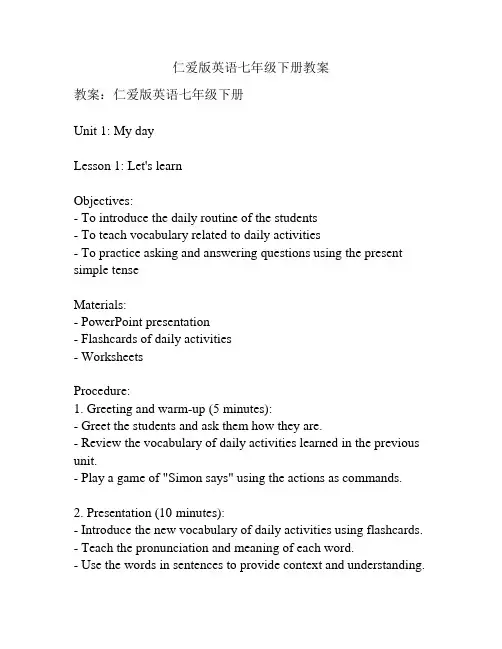
仁爱版英语七年级下册教案教案:仁爱版英语七年级下册Unit 1: My dayLesson 1: Let's learnObjectives:- To introduce the daily routine of the students- To teach vocabulary related to daily activities- To practice asking and answering questions using the present simple tenseMaterials:- PowerPoint presentation- Flashcards of daily activities- WorksheetsProcedure:1. Greeting and warm-up (5 minutes):- Greet the students and ask them how they are.- Review the vocabulary of daily activities learned in the previous unit.- Play a game of "Simon says" using the actions as commands. 2. Presentation (10 minutes):- Introduce the new vocabulary of daily activities using flashcards. - Teach the pronunciation and meaning of each word.- Use the words in sentences to provide context and understanding.3. Practice (15 minutes):- Divide the class into pairs and distribute worksheets.- Instruct the students to ask and answer questions about each other's daily routine using the present simple tense.- Monitor the students' progress and provide assistance when needed.4. Production (10 minutes):- Have the students create a daily routine timetable for themselves. - Instruct them to use the vocabulary and grammar they have learned.- Allow students to share their timetables with the class if time permits.5. Review and wrap-up (5 minutes):- Review the new vocabulary and grammar learned in the lesson. - Ask the students to summarize what they have learned today.- Give feedback and praise the students for their efforts. Homework:- Assign the students to write a short paragraph about their daily routine using the present simple tense.- Encourage them to use the vocabulary and grammar learned in the lesson.Note: Adapt the lesson plan according to the needs and abilities of the students. Provide additional activities or exercises if necessary.。
七年级下仁爱英语教案
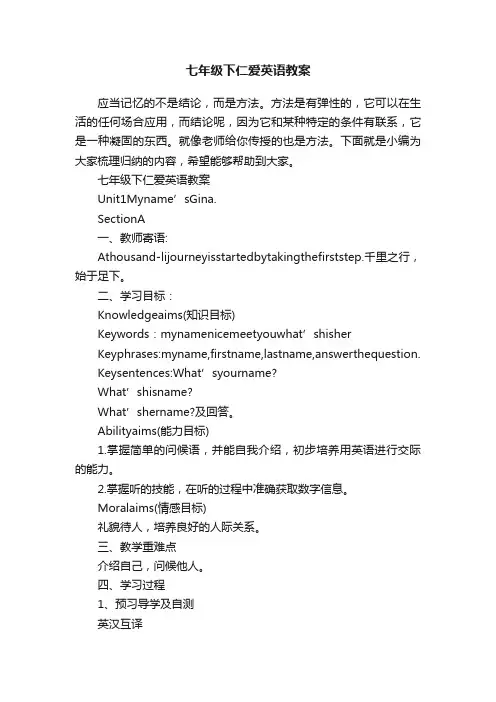
七年级下仁爱英语教案应当记忆的不是结论,而是方法。
方法是有弹性的,它可以在生活的任何场合应用,而结论呢,因为它和某种特定的条件有联系,它是一种凝固的东西。
就像老师给你传授的也是方法。
下面就是小编为大家梳理归纳的内容,希望能够帮助到大家。
七年级下仁爱英语教案Unit1Myname’sGina.SectionA一、教师寄语:Athousand-lijourneyisstartedbytakingthefirststep.千里之行,始于足下。
二、学习目标:Knowledgeaims(知识目标)Keywords:mynamenicemeetyouwhat’shisherKeyphrases:myname,firstname,lastname,answerthequestion.Keysentences:What’syourname?What’shisname?What’shername?及回答。
Abilityaims(能力目标)1.掌握简单的问候语,并能自我介绍,初步培养用英语进行交际的能力。
2.掌握听的技能,在听的过程中准确获取数字信息。
Moralaims(情感目标)礼貌待人,培养良好的人际关系。
三、教学重难点介绍自己,问候他人。
四、学习过程1、预习导学及自测英汉互译_________2.好的,令人愉快的______________3.too___________4.遇见______5.your____________6.his_________7.她的名字______2、自主学习①.onenum.1,一:Oneandtwomakesthree.一加二等于三。
adj.①一个:Ihaveonebook.我有一本书。
②有一(天):Onedayhewillunderstandyou.有一天他会理解你的。
②meet/mi:t/v.遇到,碰到【记忆法】-ee-双写,与meat为同音词。
【考点】tomeetsb.(orsth.)遇到某人/某事:Nicetomeetyou.初次见面时的客套话,不是初次见面时则用see。
初一仁爱版下册英语教案
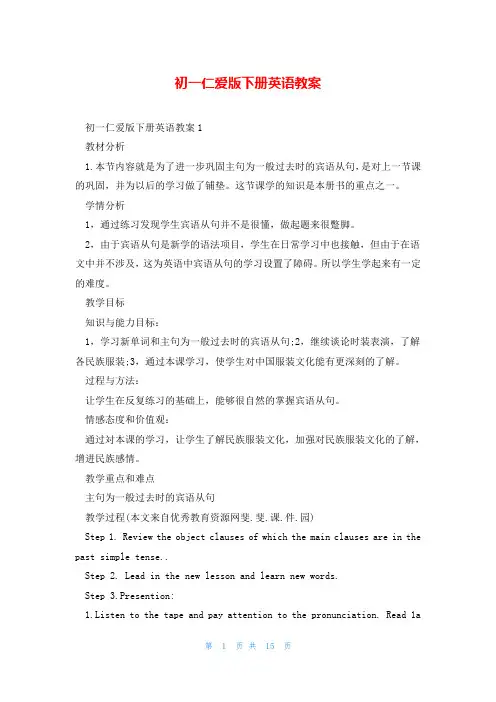
初一仁爱版下册英语教案初一仁爱版下册英语教案1教材分析1.本节内容就是为了进一步巩固主句为一般过去时的宾语从句,是对上一节课的巩固,并为以后的学习做了铺垫。
这节课学的知识是本册书的重点之一。
学情分析1,通过练习发现学生宾语从句并不是很懂,做起题来很蹩脚。
2,由于宾语从句是新学的语法项目,学生在日常学习中也接触,但由于在语文中并不涉及,这为英语中宾语从句的学习设置了障碍。
所以学生学起来有一定的难度。
教学目标知识与能力目标:1,学习新单词和主句为一般过去时的宾语从句;2,继续谈论时装表演,了解各民族服装;3,通过本课学习,使学生对中国服装文化能有更深刻的了解。
过程与方法:让学生在反复练习的基础上,能够很自然的掌握宾语从句。
情感态度和价值观:通过対本课的学习,让学生了解民族服装文化,加强对民族服装文化的了解,增进民族感情。
教学重点和难点主句为一般过去时的宾语从句教学过程(本文来自优秀教育资源网斐.斐.课.件.园)Step 1. Review the object clauses of which the main clauses are in the past simple tense..Step 2. Lead in the new lesson and learn new words.Step 3.Presention:1.Listen to the tape and pay attention to the pronunciation. Read 1ain different ways to learn it2. Let the students answer some questi. And then fill in blanks according to 1a.Step 4. PracticeLead into Part 2and practice the object clauses of which the main clauses are in the past simple tense.Step 5.Colidation :Step 6.Homework:教学环节一,复习二,导入三,呈现四,练习五,巩固六,作业复习宾语从句,然后利用宾语从句引入新课,并展示图片,学习生词,进而学习少数民族服装,处理第三部分。
最新仁爱版七年级英语下册全英文教案(全英文全册)

七耳怨英语下册全英夂教秦(全英夂全册)科厂英语Λ幅:七坪銀教师: ________________聲特科屮M嗾教学进度表姓名修或麻债亿录班级座位表最新仁爱版七年级英语下册全英文教案(全英文全册)1. Do 2a. StUdy the example to UnderStand the two WayS Of expressing means Of transportation. Then fill in the blanks in 2a. DiSCUSS and CheCk the answers ・2. Make the StUdentS find the rules Of two WayS Of expressing the Same meaning by themselves. HeIP them CheCk the rules.3. Do 2b. ASk and answer questions about the PiCtUreS in 2a , USing two WayS Of expressing means Of transportation. HeIP the StUdentS to express correctly.4. Do 3. Read the form in 3 before IiStening ・ PrediCt the IiStening material ・ Leam the new words: WatCh TV. SOCCer/football, movie/film. Then IiSten to the PaSSage about NanCy ,s activities and CheCk the COrreCt answers individually. Then CheCk the answersBlaCkbOard DeSignTOPiC 1 I USUany COme to SChOOl by subway. SeCtiOn B 1. IaIWaySgetIJPdtSiX (/clock ・ 2. The early bird CatCheS the WOrm ・3.I IISllaIIy COme to SChOOl On foot, but SOmetimeS by bike ・I SeldOm Walk to SChOOL I never COnIe to SChOOl by subway. 2. Li Xiang Often COmeS to SChOOl by bike ・Li Xiang Often rides a bike to school.never(()%) Sel(IOIn SOnletinIrS Often IISuaIIy always(100%)I 1—^1I —I ——~~Thinking after teaching:Step4 PraCtiCe (IOS)Homework:1 .Recite 10 WOrdS and finish WOrkbOOk ・ 2. P ι*actice the COnVerSatiOn Of la;3. Preview SeCtiOn C-la.StePl ReViSe (IOS)Step2 PreSentatiOn (IOS)Step3COnSOIidatiOn(IOS)Step4 PraCtiCe (IOS)1. H ave a diction.(IOwords)2. Help the StUdentS to revise the WOrdS about the days Of a Week and subjects.1. PreSent new WOrdS and new PattemS With the help Of the flashcardsand context.2. Do la. LOOk at the PiCtUre in la. PrediCt the IiStening material in la. Then IiSten to the tape and COmPlete the two COkImnS in the table in lb. Then IiSten again and COmPlete the third CoIUmn in lb. CheCk the answers.1. R ead Ia after the tape.2.r ∏ιen PraCtiCetlιeCOnVerSatiOn in Ia in PairS ・ 3. Do lb. L∞k at the table in lb. Try to Say the SentenCeS With the help Of the table.(让学生说完整的句子)1 .Create SitUatiOnS to PreSent the new phrase. CheCk the answers ・Make the StUdentS PraCtiCe the WOrdS Of SUbjeCtS orally.2. Ask and answer questions With your Partner With the PhraSeS in the box in 2a.3. Do 2b. Make the StUdentS PraCtiCe the expressions about IikeS and dislikes ・4. Work in PairS ・ LOOk at the PiCtUreS in 2b and make UP new conversations. PraCtiCe the COnVerSatiOnS in PairS ・5. D O 3.Make the StUdentS USe the expressions about IikeS and dislikes in Oral WOrk and Written WOrk after Iearning ・StePl ReViSe (IOS)Step2 PreSentatiOn (IOS)Step3 COnSOIidatiOn(IOS)Step4 PraCtiCe (IOS)l.Have a diction.(IOwords)2Revise the WOrdS about the days Of a Week and subjects. 3.Show SOme PhOtOS about sch∞l activities to arouse the StudentSqinterests.1. D o la. PreSent new WOrdS in the context. PrediCt the reading materialbefore reading ・2. L OOk at the PiCtUreS in la. Read the StatementS before reading the material. Try to guess TrUe Or FaISe before reading ・3. R ead the PaSSage in Ia individually. CirCle TnJe Or False. Then CheCk your answers With your Partner.Help the StUdentS CheCk their answers WhiIe reading ・1 .Try to SUmmariZe the main idea Of each ParagraPh.Help the StUdentS Iearn to USe their OWn WOrdS to SUnImariZe the main idea ・2.Do lb. Read Ia again and fill in the blanks in Ib individually. CheCk the answers ・1. Look at the news and POSterS in2. Try to guess the COntent in them. Then read the news and POSterS about HU Biιι,s interesting SChOOl Iife and fill iιι the blanks iιι the following table.2. Make the StUdentS Iearn to make POSterS and news by themselves ・3. Do 4a. Read the WOrdS in 4a individually. Then read the WOrdS to your partner.4. Do 4b. Read the WOrdS On PPT together, where, bear, there, chair, near, here ・ Read the Chant after the tape ・ Pay attention to the rhythm. Then PraCtiCe the Chant in PairS ・最新仁爱版七年级英语下册全英文教案(全英文全册)。
仁爱版英语七年级下全册教案
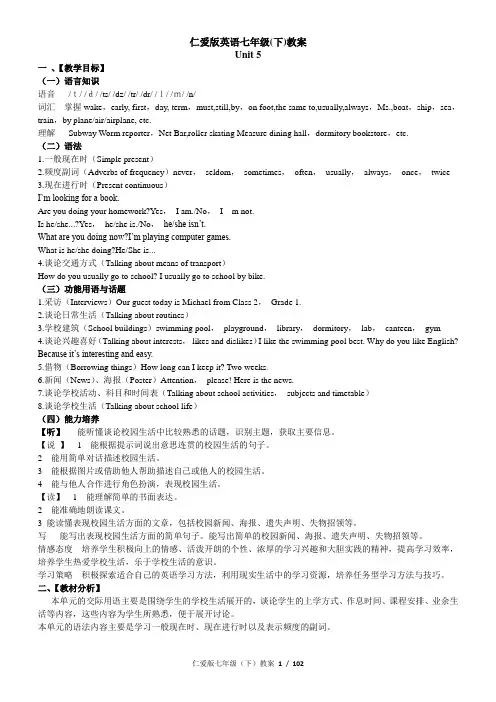
仁爱版英语七年级(下)教案Unit 5一、【教学目标】(一)语言知识语音/t/ /d/ /ts/ /dz/ /tr/ /dr/ /l/ /m/ /n/词汇掌握wake,early, first,day, term,must,still,by,on foot,the same to,usually,always,Ms.,boat,ship,sea,train,by plane/air/airplane, etc.理解Subway Worm reporter,Net Bar,roller skating Measure dining hall,dormitory bookstore,etc.(二)语法1.一般现在时(Simple present)2.频度副词(Adverbs of frequency)never,seldom,sometimes,often,usually,always,once,twice3.现在进行时(Present continuous)I’m looking for a book.Are you doing your homework?Yes,I am./No,I m not.Is he/she...?Yes,he/she is./No,he/she isn’t.What are you doing now?I’m playing computer games.What is he/she doing?He/She is...4.谈论交通方式(Talking about means of transport)How do you usually go to school? I usually go to school by bike.(三)功能用语与话题1.采访(Interviews)Our guest today is Michael from Class 2,Grade 1.2.谈论日常生活(Talking about routines)3.学校建筑(School buildings)swimming pool,playground,library,dormitory,lab,canteen,gym4.谈论兴趣喜好(Talking about interests,likes and dislikes)I like the swimming pool best. Why do you like English? Because it’s interesting and easy.5.借物(Borrowing things)How long can I keep it? Two weeks.6.新闻(News)、海报(Poster)Attention,please! Here is the news.7.谈论学校活动、科目和时间表(Talking about school activities,subjects and timetable)8.谈论学校生活(Talking about school life)(四)能力培养【听】能听懂谈论校园生活中比较熟悉的话题,识别主题,获取主要信息。
仁爱版英语七年级下全册教案 (1)
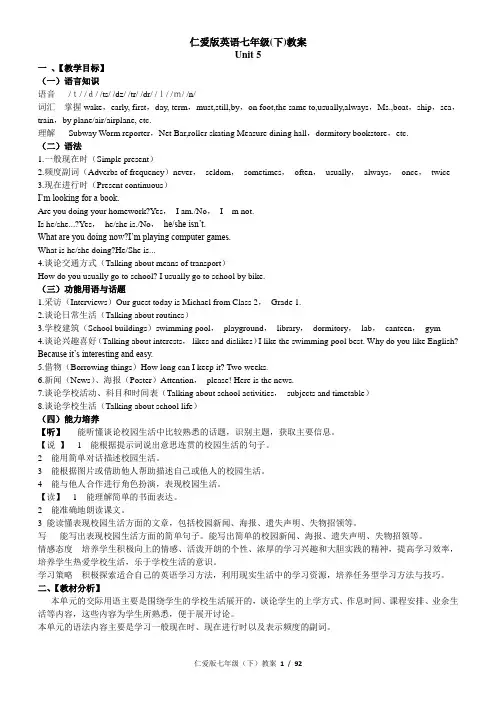
仁爱版英语七年级(下)教案Unit 5一、【教学目标】(一)语言知识语音/t/ /d/ /ts/ /dz/ /tr/ /dr/ /l/ /m/ /n/词汇掌握wake,early, first,day, term,must,still,by,on foot,the same to,usually,always,Ms.,boat,ship,sea,train,by plane/air/airplane, etc.理解Subway Worm reporter,Net Bar,roller skating Measure dining hall,dormitory bookstore,etc.(二)语法1.一般现在时(Simple present)2.频度副词(Adverbs of frequency)never,seldom,sometimes,often,usually,always,once,twice3.现在进行时(Present continuous)I’m looking for a book.Are you doing your homework?Yes,I am./No,I m not.Is he/she...?Yes,he/she is./No,he/she isn’t.What are you doing now?I’m playing computer games.What is he/she doing?He/She is...4.谈论交通方式(Talking about means of transport)How do you usually go to school? I usually go to school by bike.(三)功能用语与话题1.采访(Interviews)Our guest today is Michael from Class 2,Grade 1.2.谈论日常生活(Talking about routines)3.学校建筑(School buildings)swimming pool,playground,library,dormitory,lab,canteen,gym4.谈论兴趣喜好(Talking about interests,likes and dislikes)I like the swimming pool best. Why do you like English? Because it’s interesting and easy.5.借物(Borrowing things)How long can I keep it? Two weeks.6.新闻(News)、海报(Poster)Attention,please! Here is the news.7.谈论学校活动、科目和时间表(Talking about school activities,subjects and timetable)8.谈论学校生活(Talking about school life)(四)能力培养【听】能听懂谈论校园生活中比较熟悉的话题,识别主题,获取主要信息。
仁爱版英语七年级下册教案
仁爱版英语七年级下册教案《仁爱版英语七年级下册教案》为题在七年级下学期的英语课程中,我们将继续使用仁爱版英语教材。
为了帮助学生更好地学习英语,我们准备了一份教案,旨在引导学生进行全面、系统的学习。
第一课:Unit 1 My School Day1. Learning Objectives- Enable students to talk about their school day in English. - Familiarize students with the vocabulary related to school subjects and daily routines.- Develop students' listening, speaking, reading, and writing skills.2. Warm-up- Show pictures of different school subjects and ask students to name them in English.- Play a short video clip of a typical school day routine and ask students to describe what they see.3. Vocabulary- Introduce new vocabulary related to school subjects and daily routines through flashcards, word games, and real-life examples.4. Listening- Play an audio recording of a student's school day routine and ask students to listen and fill in the missing information on a worksheet.5. Speaking- Divide students into pairs and ask them to interview each other about their typical school day routine using the targetvocabulary.6. Reading- Provide students with a short reading passage about a school day routine and ask them to answer comprehension questions.7. Writing- Ask students to write a short paragraph about their own school day routine, using the vocabulary and sentence structures learned in class.8. Extension Activities- Role play: Divide students into groups and ask them to act out a school day routine, using the target vocabulary and sentence structures.- Vocabulary word search: Provide students with a word search worksheet containing the vocabulary words learned in this unit.第二课:Unit 2 My Hobbies1. Learning Objectives- Enable students to talk about their hobbies in English.- Familiarize students with the vocabulary related to different hobbies.- Develop students' listening, speaking, reading, and writing skills.2. Warm-up- Show pictures of different hobbies and ask students to name them in English.- Play a short video clip of people engaging in different hobbies and ask students to describe what they see.3. Vocabulary- Introduce new vocabulary related to hobbies through flashcards, word games, and real-life examples.4. Listening- Play an audio recording of people talking about their hobbies and ask students to listen and match the hobbies with the correct person on a worksheet.5. Speaking- Divide students into groups and ask them to discuss their favorite hobbies using the target vocabulary. Each group should appoint a spokesperson to present their findings to the class.6. Reading- Provide students with a short reading passage about different hobbies and ask them to answer comprehension questions.7. Writing- Ask students to write a short paragraph about theirfavorite hobby, using the vocabulary and sentence structures learned in class.8. Extension Activities- Hobby showcase: Ask students to bring in an item or a picture related to their favorite hobby and present it to the class, explaining why they enjoy it.- Hobby survey: Divide students into pairs and ask them to conduct a survey among their classmates to find out the most popular hobbies in the class.第三课:Unit 3 My Family1. Learning Objectives- Enable students to talk about their family members in English.- Familiarize students with the vocabulary related to family members and relationships.- Develop students' listening, speaking, reading, and writingskills.2. Warm-up- Show pictures of different family members and ask students to name them in English.- Play a short video clip about a family gathering and ask students to describe what they see.3. Vocabulary- Introduce new vocabulary related to family members and relationships through flashcards, word games, and real-life examples.4. Listening- Play an audio recording of a person talking about their family and ask students to listen and answer comprehension questions.5. Speaking- Divide students into pairs and ask them to interview each other about their family members and relationships using the target vocabulary.6. Reading- Provide students with a short reading passage about a family and ask them to answer comprehension questions.7. Writing- Ask students to write a short paragraph about their own family, using the vocabulary and sentence structures learned in class.8. Extension Activities- Family tree: Ask students to create a family tree, labeling each family member with the appropriate vocabulary words.- Family interview: Divide students into pairs and ask them to interview their family members about their family history, traditions, and customs.本教案只写了前三课的内容,希望能够帮助学生更好地学习英语。
仁爱版英语七年级下册教学设计
杨立春
Contents:
Unit 7 Topic2 Section A
Teaching aims
1、Learn the new phrase;
2、Learn the usage of “can” and “can’t” for ability and inability;
2、Practice1ain pairs. Then act it out.
Step4:Practice
1、Let the students finish 2 by s. And then check the answers;
2、Pair work.
Let the students ask and answer in pairs according to the example and phrases in 3.And master alternative questions.
2、Ask and answer between the teacher and the students.
3、Let the students listen to1aand follow it.
Step3:Consolidation
1、Let the students listen to1aagain, and then finish 1b;
1、What else can you do?;
2、Can you dance or draw?
Teaching plan
Students’ activities
Teaching steps:
Step2:Presentation
1、Lead to the sentence pattern “can you…?”
仁爱版七年级下册英语教案
仁爱版七年级下册英语教案Unit 1: Countries and LanguagesLesson 1: Introducing Countries and LanguagesObjectives:- To introduce and learn vocabulary related to countries and languages.- To practice asking and answering questions about countries and languages.- To develop listening, speaking, and reading skills. Materials:- Textbook: Ren'ai Grade 7, Unit 1- World map- Flashcards with country names and flags- Handouts with conversation promptsProcedure:1. Warm-up (5 minutes):- Display a world map and ask students to point out different countries.- Ask students to share the names of some countries they know, and elicit their languages.2. Vocabulary Introduction (10 minutes):- Show flashcards with names of countries and their corresponding flags.- Pronounce the country names and have students repeat after you.- Teach the names of the countries and their languages usinggesture and context.- Drill pronunciation of the words.- Make sure students understand the meaning of each word.3. Listening Exercise (15 minutes):- Play an audio recording of a conversation about countries and languages.- Students listen and complete the missing information about the countries and languages.- Play the audio again if necessary.- Check the answers as a class.4. Speaking Practice (15 minutes):- Divide students into pairs.- Provide each pair with a handout containing conversation prompts.- Students take turns asking and answering questions about countries and languages.- Monitor and provide assistance if needed.- Encourage students to use complete sentences and proper pronunciation.5. Reading Comprehension (10 minutes):- Assign the reading passage in the textbook related to countries and languages.- Instruct students to read silently and answer the comprehension questions.- Check the answers as a class.6. Homework (5 minutes):- Assign a written task for homework, such as writing a short paragraph about their favorite country and its language.- Remind students to include relevant vocabulary and proper sentence structure.Assessment:- Observe students' participation and engagement during the speaking practice.- Evaluate students' comprehension through their answers in the listening exercise and reading comprehension.。
仁爱版七年级下英语教案
仁爱版七年级下英语教案English:In the 7th grade, students will be introduced to a wide range of English topics in the Ren'ai version. The curriculum will cover grammar, vocabulary, reading, writing, speaking, and listening skills. Each unit will focus on a specific theme, such as daily routines, hobbies, school life, and travel. Students will learn to express themselves in English through various activities, including role-plays, group discussions, and project presentations. They will also be introduced to different English accents and regions to improve their listening comprehension skills. The goal is to help students build a strong foundation in English and develop confidence in using the language in various real-life situations.中文翻译:在仁爱版的七年级下册中,学生将接触到广泛的英语主题。
课程将涵盖语法、词汇、阅读、写作、口语和听力技能。
每个单元都将专注于特定的主题,如日常作息、爱好、学校生活和旅行。
- 1、下载文档前请自行甄别文档内容的完整性,平台不提供额外的编辑、内容补充、找答案等附加服务。
- 2、"仅部分预览"的文档,不可在线预览部分如存在完整性等问题,可反馈申请退款(可完整预览的文档不适用该条件!)。
- 3、如文档侵犯您的权益,请联系客服反馈,我们会尽快为您处理(人工客服工作时间:9:00-18:30)。
仁爱版英语七年级(下)教案Unit 5一、【教学目标】(一)语言知识语音/t/ /d/ /ts/ /dz/ /tr/ /dr/ /l/ /m/ /n/词汇掌握wake,early, first,day, term,must,still,by,on foot,the same to,usually,always,Ms、,boat,ship,sea,train,by plane/air/airplane, etc、理解Subway Worm reporter,Net Bar,roller skating Measure dining hall,dormitory bookstore,etc、(二)语法1、一般现在时(Simple present)2、频度副词(Adverbs of frequency)never, seldom, sometimes, often, usually, always, once, twice3、现在进行时(Present continuous)I’m looking for a book、Are you doing your homework?Yes, I am、/No, I m not、Is he/she、、、?Yes, he/she is、/No, he/she isn’t、What are you doing now?I’m playing computer games、What is he/she doing?He/She is、、、4、谈论交通方式(Talking about means of transport)How do you usually go to school? I usually go to school by bike、(三)功能用语与话题1、采访(Interviews)Our guest today is Michael from Class 2, Grade 1、2、谈论日常生活(Talking about routines)3、学校建筑(School buildings)swimming pool, playground, library, dormitory, lab, canteen, gym4、谈论兴趣喜好(Talking about interests, likes and dislikes)I like the swimming pool best、 Why do you like English? Because it’s interesting and easy、5、借物(Borrowing things)How long can I keep it? Two weeks、6、新闻(News)、海报(Poster)Attention, please! Here is the news、7、谈论学校活动、科目与时间表(Talking about school activities, subjects and timetable)8、谈论学校生活(Talking about school life)(四)能力培养【听】能听懂谈论校园生活中比较熟悉的话题,识别主题,获取主要信息。
【说】1能根据提示词说出意思连贯的校园生活的句子。
2能用简单对话描述校园生活。
3能根据图片或借助她人帮助描述自己或她人的校园生活。
4能与她人合作进行角色扮演,表现校园生活。
【读】1能理解简单的书面表达。
2能准确地朗读课文。
3 能读懂表现校园生活方面的文章,包括校园新闻、海报、遗失声明、失物招领等。
写能写出表现校园生活方面的简单句子。
能写出简单的校园新闻、海报、遗失声明、失物招领等。
情感态度培养学生积极向上的情感、活泼开朗的个性、浓厚的学习兴趣与大胆实践的精神,提高学习效率,培养学生热爱学校生活,乐于学校生活的意识。
学习策略积极探索适合自己的英语学习方法,利用现实生活中的学习资源,培养任务型学习方法与技巧。
二、【教材分析】本单元的交际用语主要就是围绕学生的学校生活展开的,谈论学生的上学方式、作息时间、课程安排、业余生活等内容,这些内容为学生所熟悉,便于展开讨论。
本单元的语法内容主要就是学习一般现在时、现在进行时以及表示频度的副词。
Topic 1Section A【教学目标】:1、谈论交通工具及如何上学。
2、学习句型:How do you usually come to school?I usually come to school by subway、【重点】1a与3a。
【难点】谈论交通工具及如何上学。
【教具】录音机【课时建议】:1~2【教学过程】:第一步:复习1、教学生如何在开学的第一天相互问候。
T: Good morning, class! S: Good morning, Miss、、、/Mr、、、T: Nice to see you again! S: Nice to see you, too、学习问候语:T: Happy New Year! S: The same to you、然后老师说:Boys and girls、Today is the first day of our new term、解释today, new term。
老师说:I often come to school by bus、 My son often takes the subway to school、 What about you?学习词组by bus, take the subway。
Notes: subway(AmE)=underground(BrE)2、听录音3a,回答问题:(1)How does Kangkang usually come to school?(2)How does Sally always come to school?两人一组作对话,然后请3~4对同学到前面表演对话。
(对参加表演的同学给予鼓励。
)完成3b。
第二步:呈现1、老师向一些同学依次展示并学习词组:wake up, get up, go to school, by bike等,然后做动作练习。
要一名同学在前作动作,其余同学猜测词组。
2、听录音1,回答问题:What’s the time? / Is it time to get up?Who wakes Kangkang up? 完成1。
3、利用图画,完成2。
4、听录音4,完成4。
第三步:巩固1、放录音1与3a,学生跟读。
2、学生两人一组表演1与3a。
第四步:练习1、分组活动,谈论自己早晨的活动情况。
2、双人活动,分别用不同的交通工具图片进行问答:A:How do you usually come to school?B:I usually come to school、、、例如:on foot, by bike, by bus, by car, by train, by subway, by boat/ship, by plane/air,完成4。
3、让学生做一个调查报告,调查全班同学“How do you usually go to school?”按人数从多到少列成表格,向大家汇报:In our class, fifteen students go to school by bike、、、完成5。
第五步:综合探究活动1、学生以表格的形式展示自己的家人通常所采用的交通方式。
2、请同学据自己所了解的情况,介绍其它中学生早晨的活动情况,如:“In our class, some students usually wake up at 6∶30、 They get up at 6∶35、、、”Section B【教学目标】:1、复习Section A。
2、学习频度副词。
【重点】1,2与3a 【难点】:频度副词【教具】录音机【课时建议】:1【教学过程】:第一步:复习1、复习Section A 4,进行a chain work 活动,按照自己的想法回答问题:How do you usually come to school?尽可能不重复前面同学的答语。
2、两人一组,使用自己准备的图片,谈论其她人的上学情况。
3、老师手指图画(一人正在骑自行车)。
This is me、 I usually ride a bike to school、教学ride a bike。
介绍go home by subway,walk to the park, go to the zoo by bus 等等。
让同学挑选自己喜欢的方式。
手拿图画谈论自己。
例如:I want to go to school by bus、4、双人活动,两同学各指一幅3a图画相互介绍:This is、、、、 He/She usually walks to school、完成3a。
5、双人活动,瞧3a图进行问答:完成3b。
A: How does Li Xiang usually go to school?B: He usually rides a bike to school、第二步:呈现1、老师教学频度副词:never, seldom, sometimes, often, usually, always。
2、学生根据自己的实际情况描述自己的日常生活。
例如:I never come to school late、Sometimes I walk to school、3、听录音1,回答问题:What time does Michael get up on weekdays?How does Kangkang usually go to school?让学生猜“The early bird catches the worm、”的汉语意思。
第三步:巩固1、听录音1与3a,学生跟读。
2、学生两人一组表演1。
第四步:练习1、双人活动,分别用不同的交通工具图片进行问答。
2、双人活动,两种乘坐交通工具的不同表达方式。
3、练习频度副词。
让学生之间互相询问:Do you often watch TV in the evening?No, I don’、 I sometimes watch TV、Sometimes I read books、4、双人活动,完成4。
第五步:综合探究活动1、学生们根据自己所了解的情况,介绍其它同学如何去上学。
2、学生们以表格的形式做一个调查报告(请仿照Section B 4),然后写一篇小短文,如:Li Ming is my good friend、 He sometimes watches TV in the evening、 He never walks to school、 He always takes the subway、、、3、课堂活动: Let’s chant、Section C【教学目标】:1、谈论学校生活。
